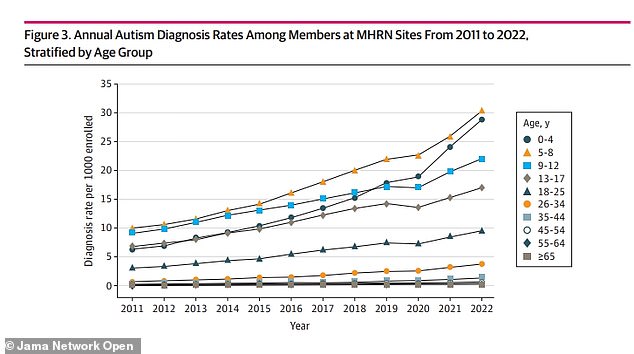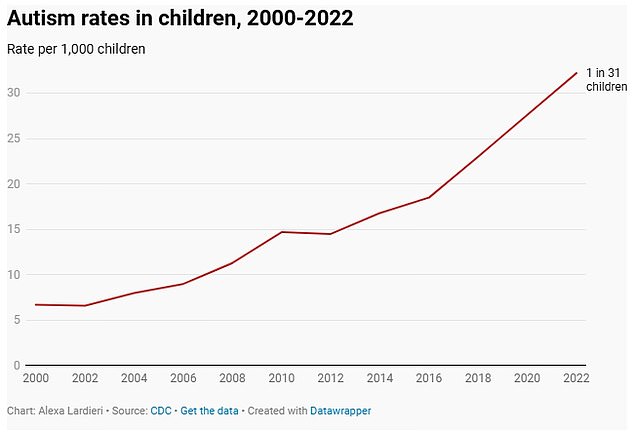- LEARN MORE: A physician explains the reasons behind the rising rates of autism in the United States
Scientists have identified four separate forms of autism, each characterized by a unique genetic profile, potentially revealing insights into the origins of the disorder and possible treatment methods.
A group from Princeton University along with the Simons Foundation examined 5,000 kids participating in SPARK, which is the largest autism research initiative in the nation. They documented their characteristics and categorized the children according to their behavioral patterns.
They analyzed over 230 behavioral and developmental characteristics—ranging from social engagement to repeated actions—and identified four categories of autism: Social and Behavioral Difficulties; Combined ASD with Developmental Delays; Mild Impairments; and Widely Impacting Conditions.
Next, they matched the subtypes with each child’s genetic makeup, examining similarities across different groups. Scientists searched for mutations passed down from parents, harmful mutations that weren’t inherited, and variations in gene expression.
Previously, scientists thought the genetic causes of autism occurred during pregnancy, but this research discovered that DNA abnormalities can influence different types of autism either before or after birth. Autism subtypes vary based on when these genetic changes occur, affecting various developmental phases.
Aviya Litman, a doctoral candidate at Princeton University and one of the lead authors, stated, "These results are significant as the categories reflect varied medical manifestations and prognoses, and importantly, we managed to link them to specific biological foundations."
Scientists have found that typical genetic variations explain approximately 20% of autism spectrum disorder cases, with the other 80% attributed to a complicated combination of environmental influences, changes in DNA that control how genes function, and gene-environment interactions which scientists have yet to completely comprehend.
Their discoveries open up possibilities for parents to better understand their children and assist them through key stages with appropriate care, including occupational therapy. They might also introduce innovative genetic treatments for individuals significantly affected by autism.

To examine information from the 5,000 kids, scientists employed a computerized model to categorize kids according to a mix of more than 230 distinct characteristics someone might possess, including repeated actions, responsiveness to noise, issues with large muscle movements, and dislike for specific materials.
This led to the formation of four subtypes, which scientists associated with distinct genetic patterns and different paths of development.
Natalie Sauerwald, an associate research scientist at the Flatiron Institute and co-lead author, stated: “What we're observing isn’t merely a single biological account of autism, but several separate stories.”
This explains why previous genetic research frequently failed—it was similar to attempting to complete a jigsaw puzzle without understanding that we were dealing with several distinct puzzles combined.
A total of 37 percent of the children involved in the study belonged to the Social and Behavioral Challenges category, exhibiting typical signs of autism such as problems with social interaction and recurring actions, but they continue to reach their development goals within expected timelines.
This subgroup stands out due to its elevated prevalence of concurrent psychological disorders. Individuals often exhibit ADHD, anxiety, depression, or OCD along with their autism spectrum disorder diagnosis.

Often, these hidden difficulties take precedence over children's requirements. The reality that they continue to meet growth targets at the expected time might account for why numerous kids with this type of condition remain undiagnosed until they face increased social expectations during their school years.
Individuals belonging to the Mixed ASD with Developmental Delay category (19%) often experience delays in reaching important developmental markers such as speaking their first words and learning to walk. However, unlike those in other subgroups, they typically do not exhibit symptoms of anxiety, depression, or behavioral issues.
The term "mixed" indicates their diversity in fundamental autistic characteristics — some experience significant difficulties with social interactions but have less pronounced repetitive actions, whereas others exhibit the reverse trend.
Only the Mixed ASD accompanied by Developmental Delay group had a higher probability of possessing uncommon hereditary genetic mutations.
Kids categorized under the Mild Difficulties type (34%) are those who have the least severe version of the condition and display less intense main characteristics of autism, yet they typically reach developmental milestones within expected timelines.
Notably, these children do not experience the psychological challenges seen in the first subgroup, indicating they might require fewer extended interventions like drugs and counseling.
The Group Widely Affected experiences the greatest impact from the condition and constitutes 10 percent of the children involved in the research.
They encounter various obstacles, such as delayed development, issues with social interaction and communication, repeated actions, and additional mental health problems including anxiety, depression, and emotional instability.
They are also more prone to harbor harmful gene mutations that were not passed down from their parents. Different categories exhibited distinct genetic foundations.

"These results suggest particular theories connecting multiple processes to distinct manifestations of autism," Dr. Litman stated, highlighting variations in biology among children with different types of autism.
Approximately 2.3 million kids and 7 million grown-ups in the United States are affected by ASD.
More diagnoses are being made each year. As per the CDC, approximately one out of 150 children received an ASD diagnosis in 2000. By 2020, this number had significantly increased. to one in 36 .
An analysis conducted in 2024 using electronic health records from over 12.2 million Americans revealed that cases rose by roughly 175% increase over 11 years .
Health professionals specializing in public health, pediatrics, and child psychology suggest that the increase in cases stems from greater recognition of autism and neurodiversity along with improved detection methods for children.
The head of Health and Human Services, Robert F Kennedy Jr., has prioritized uncovering the causes of autism and understanding why its occurrence has risen significantly.
He mentions substances, nutrition, and environmental poisons as potential reasons for the rise.
Senior research author Olga Troyanskaya, head of the Princeton Precision Health and Lewis-Sigler Institute for Integrative Genomics, stated: "Grasping the genetic aspects of autism is crucial for uncovering the biological processes involved in the disorder, facilitating earlier and more precise diagnoses, and supporting tailored treatment approaches."
Read more


%20(1024%20x%201024%20piksel)%20(5).png)
%20(1024%20x%201024%20piksel)%20(1).png)
0 Comments